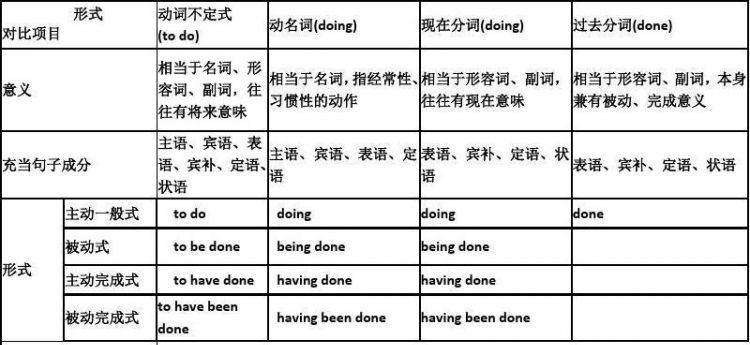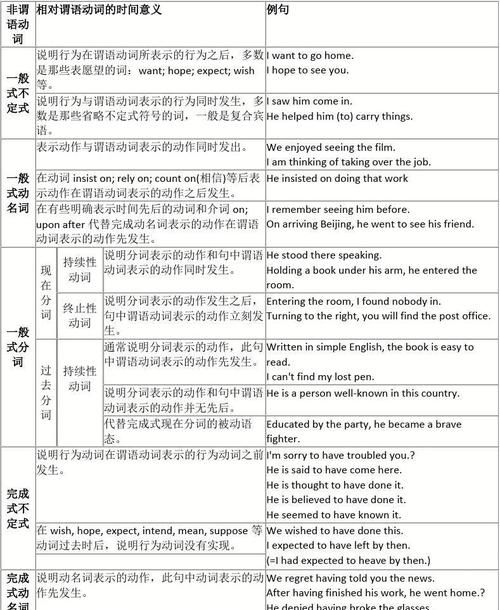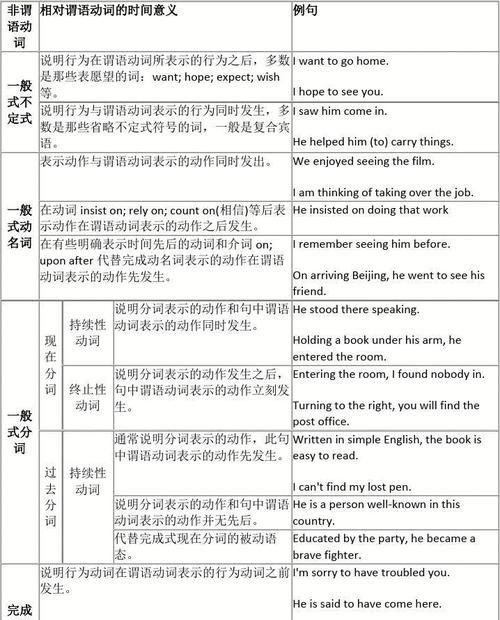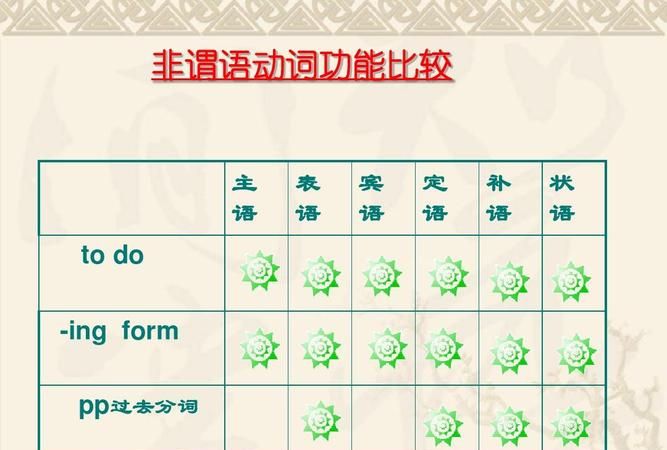本文目录
非谓语动词的用法
第九章:非谓语动词用法
【1.0】非限定性动词学习
【2.0】非限定性动词定义
【3.0】非限定性动词分类
【4.0】非限定性动词特点
【5.0】非限定性动词用法
【2.0】非限定性动词定义:不能在句中单独作谓语,并且没有人称和数的变化,不需要和主语保持人称和数的一致,不受主语限制的动词叫非限定性动词,也叫非谓语动词.
【3.0】非限定性动词分类:
【3.1】动词不定式(to do )
【3.2】动名词(doing )
【3.3】现在分词(doing)
【3.4】过去分词(done)
【4.0】非限定性动词特点
【4.1】不能单独在句中作谓语
【4.2】可以和助动词以及情态动词构成句子谓语
【4.3】 具有限定性动词特点。
【4.4】后面可以跟自己的宾语和状语.
【4.5】 具体有时态和语态的变化
【4.6】具有名词,形容词,副词等特点
【5.0】非限定性动词用法
【1.0】非限定性动词学习
【2.0】非限定性动词定义
【3.0】非限定性动词分类
【4.0】非限定性动词特点
【5.0】非限定性动词用法
【2.0】非限定性动词定义:不能在句中单独作谓语,并且没有人称和数的变化,不需要和主语保持人称和数的一致,不受主语限制的动词叫非限定性动词,也叫非谓语动词.
【3.0】非限定性动词分类:
【3.1】动词不定式(to do )
【3.2】动名词(doing )
【3.3】现在分词(doing)
【3.4】过去分词(done)
【4.0】非限定性动词特点
【4.1】不能单独在句中作谓语
【4.2】可以和助动词以及情态动词构成句子谓语
【4.3】 具有限定性动词特点。
【4.4】后面可以跟自己的宾语和状语.
【4.5】 具体有时态和语态的变化
【4.6】具有名词,形容词,副词等特点
【5.0】非限定性动词用法
(二):动词不定式(to do )概念及形式:
动词不定式:动词不定式属于非谓语动词其中一种,在句中无人称和数的限制,并在句中起名词;形容词;或副词作用的成分,其形式有2种;一种带不定式符号“to” ,一种不带不定式符号“to ”.
(一)作主语:相当于名词或代词的,往往用it 作形式主语替代,不定式真正主语放在句末
【1】To learn English is not easy .学英文不是容易事情
【2】To see is to believe.眼见为实
【3】It is difficult to learn Russian well .
学好俄语是很难的事情
【.4】 It is so hard for foreigners to learn Chinese
学汉语对外国人来说是非常难的
【5】It is the duty of the police to preserve public order.
警察的职责是维持公共持续
【6】It is kind of you to see me off at airport
你能在机场为我送行,真是太友好了
【7】It is necessary to make a study plan
制定一个学习计划是很有必要的
【8】It is important for students to go over their lessons after class
对学生来讲,课后复习他们功课是非常重要的
【.9】It is necessary for us to learn a foreign language
对我们来说,学一门外语是非常必要的
【10】It is possible for you to do the work
【11】To live in China is Mr.Smith’dream=It is Mr.Smith’s dream to live in China
在中国生活是史密斯的梦想
【12】To stop the work now seems impossible =It seems impossible to stop the work now
现在停止这项工作似乎是不可能的
【13】To lean out of the window is dangerous.
把身子伸出窗外是危险的。
【14】To talk with him is a great pleasure.
和他谈话是一件非常愉快的事。
【15】To die for the people is a glorious death!
为人民而死,虽死犹荣。
动词不定式短语作主语时,往往放在谓语动词的后面,而在句首用引词"作语法上的主语。上述两句即可改为:
【16】It is a great pleasure to talk with him.
和他谈话时件非常愉快的事情
【17】It is a glorious death to die for the people.
为人民而牺牲是光荣的牺牲
注意也常用"It is+形容词+动词不定式短语"这样的句型:
【18】It is necessary to make a plan for this course of study.必须订一个学习这门课程的计划。
【19】It is not difficult to learn a foreign if you spend time and effort on it. 小只要你花时间下功夫,学好一门外国语并不难。
【20】It's just impossible to see that and not weep.看见那种情景而不哭是根本不可能的。(注意weep之前省去了to,以免重复)
(备注:当动词不定式比较长时,应该用it 作形式主语,把真正作主语不定式放到句子后面;动词不定前面可以加入for somebody 或者of somebody充当其逻辑主语;其句子结构为It is +形容词/名词+ for somebody / of somebody to do something;后面可以接of 的形容词:kind,bold,brave,clever,
honest,stupid
Right,wise;后面可以接for 的形容词有easy,difficult, important,heavy, necessary,possible )
(二)动词不定式(to do )作表语:表示主语职业;职责;内容;或性质;以及主语为what引导的名词行从句,起表语也可以用不定式
【1】 This house is to let (不定式放在系动词之后)
此房子出租
【2】 Her plan is to finish the work in two months
她的计划是在2个月完成这项工作
【3】His wish is become a teacher
他的愿望是成为一个老师
【4】It is for you to decide (不定式复合结构作表语)
这个需要由你来决定
The question is for you to answer
这个问题得由你来回答
【5】Our duty is to help those children (to)find their parents
我们职责是帮助那些孩子找到他们的父母
【6】Her job is to take care of the sick people
她的工作是照顾那些病人
【7】The intention of this book is to introduce popular music
这本书的目的时介绍流行音乐
【8】my wish is to travel around the world
我的愿望是周游世界
【9】what strikes me most is to see him always busy
给我印象最深的看见他一直都很忙
【10】what made me fail is to ignore the facts
让我失败的是忽视了这些事实
【11】To learn a language is to use it
学一门语言就是要使用它
【12】To save is to produce
节约等于创造
【13】Her wish is to become an astronaut.她的愿望是成为一名宇航员。
【14】Our plan is to finish the work in two weeks.我们的计划是在两周内完成这项工作。
【15】His only desire was to be useful to the country.他唯一的愿望是做一个对国家有用的人。
(三)动词不定式(to do )作作宾语:主要是作某些特定的动词后面的宾语;需要熟练记住那些动词.
【1】 She promised to come back /return in half an hour
她答应半小时后回来
【1】He can not afford to buy a car
他买不起一辆汽车
【2】I hope to see you soon
我希望很快见到你
【3】I think it necessary to help each other
我认为相互帮助是必要的
【4】I find it impossible to get everything ready in time
我觉得及时准备一切事情是不可能的
【5】He considered it better not to go
他认为还是不去为比较好
【6】He wants to be a village school teacher in a mountain area.他要做个山村教师。
【7】Do you like to watch football matches? 你喜欢看足球赛吗?
【8】Learn to walk before you run.先学走后学跑。
【9】We decided to make changes in our plan.我们决定把计划做些修改。
(备注:能接动词不定式作宾语的动词有:agree; begin;choose;decide;hope;learn;
like;offer;pretend;Promise;refuse;start;)
want;wish;fail;plan; 当动词不定式后面带补足语时,可以用it 作形式宾语,并把真正作宾语动词不定式放在句子后面;不定式作宾语后可以接补语的动词有:feel,find,judge,make,think,believe,consider )
(四)动词不定式(to do )作宾语补足语(不定式复合结构):主要是接特定动词后面做宾语补足语有些接“to ”不定式有些接不带“to ”不定式
【1】I want him to come 我想他来
【2】We consider him to be a good teacher
我们认为他是一个好老师
(备注:不定式可以和名词及代词构动词成复合结构;这样动词有:ask,tell, invite,allow,force,compel, oblige,help, wish,permit,want,like,prefer, expect,advise,persuade,
order ,urge,command,get.)
【3】I will get someone to repair the computer for you.
我们将会安排人为你修理那台电脑
【4】May I invite you to be present at the meeting?
我可以邀请你出席这场会议吗?
【5】The burglar forced this man to open his safe with gun
这个窃贼用枪逼迫那个人打开他的保险箱
【6】I saw the train come into the station
我看见火车开进了这个车站
【7】He does not let her go home alone
他不让他单独回家
【8】What makes you think like that ?
是什么让你那么认为的?
【9】We often hear him sing this old song
我们经常听见他唱这首老歌
【10】He is often heard to sing this old song
他被别人听见唱了这首歌曲
【11】He got someone to repair the door.他请人修理门。
【12】I persuaded my brother to change his mind.我说服我弟弟改变了主意。
【13】The doctor advised him to take a good rest.大夫劝他好好休息。
【14】Make the past serve the present and foreign things serve China.古为今用,洋为中用。
【15】He let me go home.他让我回家。
【16】We must have someone repair the refrigerator.我们必须叫人来修电冰箱。
【17】I heard him speak in the next room.
我听到池在隔壁房间里讲话。
【18】Mother is helping pat (to) clean her shoes.
妈妈正帮蓓蒂刷鞋子。
(备注,在一感,feel ,二听hear ,listen to ,三使have,let,make,五看 see, observe,notice,watch, look at 等动词后面跟复合宾语时,不定式“to"需要省略;但是被动语态”to"要加上口诀 一感五看三使两听=已感吾看三室两厅)
不带“to”的几种不定式几种特殊情况
(2)同一结构中的省略(and/ or )
【11】I want to finish my homework and go home
我想完成我家庭作业后然后再回家
I am really puzzled what to think or say
对想什么,说什么,我真的感觉很迷惑
特殊情况:To be or not to be , this is a question
是还是不是,这个是个问题
【12】 He is better to laugh than to cry (表示对比)
他笑起来要比哭起来要更好
(3)不定式作表语一般后面要加他“to”,但是前面如果有“do”时,则后面“to”应该省略
【13】The purpose of new technologies is to make life easier,not to make it more difficult.
新技术的目的时生活变得更容易而不是更困难
【14】What he did was lose the game
他所做的事输了这场比赛
【15】All that he can do is walk home
他所能做的事走着回家
5. 句子中含有动词do时,except ,but,besides,such as等后面to 省略
【16】Don't do anything silly, such as marry him
不要做傻事,像嫁个了他
【17】He wants to moved to France and marry this girl
他想移居法国然后娶了这个女孩
【18】He wants to do nothing but go out
除了出去,他什么事情都不想做
【19】She has no choice but to accept this method
除了接受这个方法,她已经没有任何选择
【20】He wants to do anything except go to school
除了去上学,他想做任何事情
【21】He wants to believe anything but to take the medicine
除了吃药,他什么都相信
6. 主句含有不定式why,why not, had better,或者rather than , can't but后省略to
【22】He could not but walk home
他不得不走路回去
【23】Why not try going by a boat for a change
为什么不改变一下,坐船去了呢?
【24】Why not take a holiday
为什么不度个假呢?
【25】You had better do this job by yourself
你最好还是亲自做这个工作
【26】He would rather die on his feet than live on his knees
他宁愿站着光荣牺牲,也不要跪着求活
通常在discover, imagine, suppose, think, understand等词后,可以省去to be:
【27】He is supposed (to be) nice. 他应该是个好人。

非谓语动词怎么用三种形式
动词的非谓语形式有三种:不定式、动名词和分词。
不定式
不定式由“to+动词原形”构成,其否定形式是“not to do”。不定式可以带宾语或状语构成不定式短语。不定式没有人称和数的变化,有时态和语态的变化。不定式可以作主语、宾语、状语、表语和定语。不定式复合结构为“介词+sb.(sth.)+to do”,其中“介词+sb.(sth.)”表明不定式动作的发出者,为逻辑主语。
1. 不定式的用法:
(1)作主语。不定式短语作主语时,为了使句子结构平衡,常将不定式短语放在谓语之后,而用it作形式主语。
It is our duty to give as much help as possible. 提供尽可能多的帮助是我们的职责。
但不定式作表语时,前面有不定式作主语,不定式不可位于句末。
To see is to believe. 眼见为实。
(2)作宾语。常见的只跟不定式作宾语的动词(组)有want, wish, hope, expect, would like (love),care, choose, learn, plan, prepare, mean, agree, promise, offer, refuse, ask, beg, decide, make up one’s mind, be determined, manage, try, can’t afford, fail, pretend等。
①He promised to come today, but he hasn’t turned up yet .
他许诺说今天来,但他到现在还没有出现。
②No one likes to be laughed at. 没人喜欢被嘲笑。
有形容词、分词、名词作宾补,不定式作宾语时要将不定式放于句末,用it 来作形式宾语。如:
You may find it necessary to finish the work ahead of time.
你会发现有必要提前完成工作。
(3)作宾语补足语。常见的跟不定式作宾补的动词有ask, order, advise, like, want, teach, force, forbid, beg, allow, expect, cause, invite, tell, know, call on, depend on, wait for等。
The children asked their parents to take them to the park.。
孩子们要求父母带他们去公园。
感官动词后,如 see, watch, look at, observe, notice, hear, listen to, feel及部分表示“使”、“让”的使役动词,如have, make, let 跟不定式作宾补时要省略不定式符号to。但在被动语态中to 要加上。
Though he had often made his sister cry, today he was made to cry by his sister.
尽管他总是弄哭他妹妹,今天却被妹妹弄哭了。
help后的不定式作宾补(包括作宾语)to 可有可无。
(4)作表语。
My job is to help the patient. 我的工作是帮助病人。
要注意不定式作表语与“be to do”结构的不同:
不定式作表语说明主语的性质或内容,而“be to do”结构表示安排要做的事情。
①My next plan is to draw a picture for the house.(不定式作表语)
我下一个计划是为这座房子画一幅图。
②We are to meet at the school gate at six .(be to do表示安排)
我们约好六点在学校门口见面。
(5)作定语
①表示将来的动作。
The meeting to be held next week will be of great importance.。
下周将要举行的会议极为重要。
② 用在固定搭配中。
I will go to Shanghai tomorrow. Have you anything to be sent to your son?
我明天要去上海,你有什么东西要带给你儿子吗?
(send的动作发出者并非you,因此不定式用被动语态)
作定语的不定式如果与其前面所修饰的名词有逻辑上的动宾关系,然而动词又为不及物动词,动词后要加介词或副词,使其成为及物动词词组。
Will you find me a pen to write with? 你能给我找一支写字的笔吗?
不定式所修饰的词是time, place, way时,不定式后面的介词习惯上要省去。
Do you think it is the best way to deal with such a problem?
你认为这是解决问题的最好方式吗?
(6) 状语。表示目的、原因、结果。
①They ran over to welcome the guests. 他们跑过去欢迎客人。(目的)
②The child is too young to go to school. 孩子太小不能去上学。(结果)
③We were excited to hear the news. 听到这个消息我们激动了。(原因)
不定式的时态与语态
不定式有一般式、进行式、完成式形式,既有主动语态又有被动语态两种语态。形成to do, to be done, to be doing,to have done, to have been done形式。
(1)不定式的一般式所表示的动作通常与谓语的动作(状态)同时(或几乎同时) 发生,或是在它之后发生。
I’m sorry to tell you that you are wrong this time.
我很遗憾告诉你这次是你错了。
(2)如果谓语表示的动作(情况)发生时,不定式表示的动作正在进行, 这时不定式就要用进行式。
I am very glad to be talking with you. 我很高兴与你交谈。
(3)如果不定式的动作发生在谓语动词之前,就要用完成式。
I’m sorry to have kept you waiting for such a long time. 对不起,让你久等了。
当不定式逻辑上的主语是这个不定式所表示的动作的承受者时, 不定式要用被动语态。
He asked to be sent to work in the countryside. 他要求去农村工作。
动名词
动名词由“动词+ing”构成;具有动词和名词的性质,可以有宾语或状语; 可作主语、宾语、表语和定语。动名词有时态和语态的变化。
1. 动名词的作用
(1)作主语。
动名词短语作主语时,为了使句子平衡,常将动名词短语放在谓语之后,而用it作形式主语。
It is useless arguing with him about such a matter. 跟他争论这样的事情是没用的。
动名词和不定式都可作主语,在许多情况下可以通用,但动名词作主语多表示一般或抽象或多次的行为,不定式作主语往往表示具体的或一次性的动作。
在 It is no use/good, not any use/good, useless后人们习惯上用动名词。
(2)作宾语
下列动词(组)只能接动名词作宾语
admit, advise, allow, appreciate, avoid, consider, delay, enjoy, escape, excuse, finish, imagine, mind, pardon, permit, practise, suggest, require, be (get) used to(习惯于...), cant’t help(禁不住), feel like, set about, stick to, keep on, look forward to, devote oneself to, insist on, pay attention to, be worth, give up, put off。
下列动词后跟不定式或动名词意义区别不大:
begin, start, love, continue, hate, prefer。
下列动词后跟不定式或动名词意义不同,在平时学习中应特别注意。
forget, remember, regret, try, stop, mean, go on, can't help。
下列动词后跟动名词主动语态,不定式被动语态作宾语表示被动。
need, want, require。如:
These clothes need mending (to be mended).
(3) 作表语
动名词作表语多表示抽象性的或习惯性的动作,当表示下一步打算时多用不定式作表语。
①My job is teaching you English. 我的工作是教你英语。
②Her next step is to get as much money as she could to build the factory.
她下一步是获取尽可能多的资金建造工厂。
(4)作定语
动名词作定语表示用途,而不是正在进行着的动作。
He is now in the sleeping car. 他现在在房车里。
2. 动名词的复合结构
动名词的复合结构指在动名词前加物主代词或名词所有格。物主代词或名词所有格表明动名词动作的发出者。
His coming late made the teacher angry. 他的迟到让老师生气。
动名词的复合结构在句中作宾语时,物主代词或名词所有格可以变为人称代词的宾格或名词的普通格,但复合结构作主语时不变任何变化。
He entered the room without anyone noticing him.
他进入房间,没有人察觉到他。
Li Ming’s smoking ( 不可用Li Ming smoking) in the classroom surprised us.
李明在教室里吸烟让我们很吃惊。
3. 动名词的时态与语态
动名词的时态分为一般式和完成式两种形式。如果动名词的动作发生在谓语动词之前,则运用完成式;如果与谓语动词的动作同时发生或在其后发生,用一般式。
I’m sorry for not having kept my promise.
对不起,我没有遵守诺言。
若动名词与其逻辑主语有被动关系,则运用被动语态形式。( 但有些动词后运用主动形式表达被动概念,除上述动词外,be worth后也跟动名词主动形式表达被动概念)。
He entered the room without being noticed.
他进入房间而没被察觉。
分词
分词分为现在分词和过去分词。
1. 区别
(1)现在分词表示主动,过去分词表示被动。
①The man standing by the window is our teacher.
②The house built last year has become our lab.
(2)现在分词表示事物本身所具有的性质,意为“令人……的”; 过去分词表达由外界引起的内心活动,意为“感到……的”。
the exciting news 激动人心的消息。(令人兴奋的消息)
the excited look 激动的表情。
(3) 现在分词表达正在进行着的动作,过去分词表达完成的动作。(这一类动词主要为不及物动词)
①Electricity lines as well as telephone poles were brought down by falling trees or branches.
②The army was called in to cut through fallen trees and... .
2.分词的时态和语态
过去分词表示被动或完成的动作,因而没有完成式和被动语态。
现在分词有一般式和完成式两种形式, 有主动语态和被动语态两种语态,形成doing, having done, having been done的形式。
3. 分词的用法
(1)作定语
单个分词作定语一般放在所修饰词的前面,短语作定语放在所修饰词的后面。
①The question being discussed is important to us.
②The excited people rushed into the building.
(2)作状语
分词或分词短语作状语时,可以表示时间、原因、行为方式、结果、伴随状况等。
①Having been shown around the lab, we were led into a big hall. (时间)
②Being a student, I must study hard.(原因)
③They worked day and night, finishing the work ahead of time.(结果)
不定式也可以作结果状语,然而不定式多表达意料之外的结果,而现在分词表达意料之中的结果。
①She went to Shanghai specially to see her brother, only to find that he had gone to Beijing a few days before.
她专程去上海看望她的兄弟,却发现他几天前去了北京。
②They got up very early that day, finding nobody in the station when they got there.
那天他们很早就起床了,到了车站却发现那里空无一人。
(3)作表语
①The news is inspiring. 这消息令人鼓舞。
②The window is broken. 窗户破了。
(4)作宾补
①We had the fire burning all day. 我们让这火整天烧着。
②I’m afraid I can't make myself understood when I speak English.
我担心当我说英语是别人听不懂。
不定式被动语态、现在分词被动语态、过去分词表示被动应该注意的几个问题。
1. 不定式的被动语态作状语时多表达目的,相当于in order to be done, 而过去分词则表示原因、条件、伴随等;现在分词被动语态的完成式强调分词的动作发生在谓语动词动作之前。
①In the circus, the tamed animals will be given some food when they finish tricks. To be given more food, the animals will try their best to please the trainer.
在马戏团里,当驯兽完成它们的把戏,会得到一些食物。若要得到更多食物,它们就要尽其所能来取悦驯兽师。
(To be given...=In order to be given...,表示目的,此处不可用Given 或 Being given)
②Having been asked some very difficult questions, the boy came into the office.
男孩被问了一些很难的问题后,来到办公室里。
(Having been asked...=After he was asked..., 表示ask 的动作发生在come 之前)
2. 不定式的被动语态作定语表达将来的动作, 过去分词作定语表达过去或完成的动作,现在分词被动语态的一般式表达一种正在进行的动作。
①The meeting to be held next week is about how we can deal with this problem.
下周要开的会是关于我们如何解决这个问题的。
(to be held=which is to be held, be to 在此表达将来)
②The book published last month sells well. 上月出版的那本书卖得很好。
( published = which was published, published不可用to be published或being published代替)
③The building being built now will be finished in ten days. 正在建筑的那栋楼,10天内完工。
(being built=which is being built, 表示正在进行的动作)
3. 作宾补时,若非谓语动词与其前面的宾语有逻辑上的被动关系, 表示感官的动词,如 see, find, watch, notice, hear, feel 及部分使役动词,如:have, keep, get, let 等后跟过去分词作宾补;allow, advise,forbid, permit, want, order 等后跟不定式被动语态作宾补。
①The Emperor ordered the cloth to be woven for him right away.
皇帝命令说立刻为他织那块布。
②When she got home, she found her windows broken.
当她回到家时,发现窗户破了。

非谓语动词语法讲解ppt
非谓语动词用法详解
动词的非谓语形式有三种:不定式、动名词和分词
(一)不定式
不定式由“ to十动词原形”构成,其否定形式是“ not to do”.不定式可以带宾语或状语构成不定式短语,没有人称和数的变化,但有时态和语态的变化.不定式可作主语、宾语、状语、表语和定语,但不能单独作谓语.不定式的逻辑主语有时用“ for十名词或代词宾格”构成.
1.不定式的用法:
l)作主语.不定式短语作主语时,往往放在谓语之后,用 it作形式主语.例如:
To see is to believe.
It is right to give up smoking.
2)作宾语.不定式短语作宾语时,如果还带有宾语补足语。往往把不定式宾语放在宾语补足语之后,而用 it作形式宾语.例如:
He wanted to go.
I find it interesting to study work with him.
3)作宾语补足语.例如:
He asked me to do the work with him.
注意 :在 feel,hear,listen to,look at,notice, observe,see,watch,have, let,make等词后的补足语中,不定式不带 to.但是这些句子如果变成被动结构时,就必须带 to.例如
I often hear him sing the song.
He is often heard to sing the song.
注意:不定式动词在介词 but,except,besides后面时,如果这些介词之前有行为动词 do的各种形式,那么,这些介词后的不定式不带 to,否则要带 to.如:
She could do nothing but cry.
What do you like to do besides swim?
I have no choice but to go.
4)作定语.例如:
I have some books for you to read.
注①作定语的不定式如果是不及物动词,或者不定式所修饰的名词或代词是不定式动作的地点、工具等,不定式后面须有相应的介词.例如:
He is looking for a room to live in.
There is nothing to worry about.
Please give me a knife to cut with.
但是,不定式所修饰的名词如果是 time,place或 way,不定式后面的介词习惯上要省去.例如:
He had no money and no place to live.
注②当作定语的不定式所修饰的名词或代词是不定式动作的承受者时,不定式既可以用主动语态,也可用被动语态,但其含义有所不同.试比较:
A) Have you anything to send? 你有什么东西要寄吗?
(不定式 to send的动作执行者是 you)
B) Have you anything to be sent? 你有什么要(我或别人)寄的东西吗?
(不定式 to be sent的动作执行者是已被省略的 me或someone else)
5)作状语,表示目的、原因、结果或条件.例如:
I came here to see you.(目的)
We were very excited to hear the news.(原因)
He hurried to the school to find nobody there.(结果)
To look at him, you would like him.(条件)
目的状语还可以用 in order to或 so as to来表示.如:
In order to pass the exam, he worked very hard.
We ran all the way so as not to be late.
不定式也可在作表语用的形容词后面作状语.例如:
I am very glad to hear it.
The question is difficult to answer.
“ too十形容词或副词十不定式”作状语.例如:
He is too old to do that.
另外句子中有 enough这个词时,常用不定式作状语.例如:
The room is big enough to hold us.
6)作表语.例如:
My job is to help the patient.
7)作独立成分.例如:
To tell the truth, I don’t agree with you.
8)不定式与疑问词 who,which,when,where,how,what等连用,在句中起名词作用,可充当主语、表语、宾语等.例如:
He didn’t know what to say.(宾语)
How to solve the problem is very important.(主语)
My question is when to start. (表语)
注意:在与 why连用时,只用于 why或 why not开头的简短疑问句中,后面紧跟的动词不定式不带 to. 例如:
Why not have a rest?
9)不定式在句中用主动式还是被动式。多数情况下是容易判别的,但有时的确比较复杂,请注意以下几点:
A)不定式修饰的名词或代词和不定式构成逻辑上的主谓关系时,不定式往往用主动形式.
Have you got a key to unlock the door?
(A key unlocks the door.)
B)不定式和它前面被修饰的名词或代词构成逻辑上的动宾关系,又和该句主语构成逻辑上的主谓关系时,不定式常用主动形式.
I have got a letter to write.( I write letter.)
He needs a room to live in.( He lives in a room.)
I know what to do.( I do what.) 但这句如改为下列形式,不定式就得用被动形式:
I know what is to be done.
这是因为 what is to be done是宾语从句,从句中的主语 what是动词 do的动作对象
C)不定式作表语形容词的状语,和句中主语构成逻辑上的动宾关系时,不定式多用主动形式,这是因为人们往往认为形容词后省去了 for one或 for people.例如:
He is hard to talk to.( to talk to him.)
The book is difficult to understand. ( to understand the book.)
但如果强调句中的受事者时,亦可用不定式被动式,例如:
The handwriting is very difficult to be read.
The box is too heavy to be lifted.
D)在 “there十be” 的结构中,当说话人考虑的是必须有人去完成某件事时,不定式用主动形式,如果说话人强调的是事情本身必须完成,则用被动形式.
There is a lot of work to do. ( Somebody has to do the work.)
There is a lot of work to be done. ( The work has to be done.)
请注意下面两个句子的含义是不同的:
There is nothing to do. 意为无事可做,感到十分乏味.
There is nothing to be done.意为某东西坏了,无法使之恢复正常.
2.不定式的时态
l)不定式的一般形式所表示的动作,通常与谓语的动作(状态)同时(或几乎同时)发生,或是在它之后发生.例如:
I saw him go out.
2)如果谓语表示的动作(情况)发生时,不定式表示的动作正在进行,这时不定式就要用进行式.例如:
I am very glad to be working with you.
3)如果不定式的动作发生在谓语动词之前,就要用完成式.例如:
I’m sorry to have kept you waiting.
3.不定式的语态
当不定式逻辑上的主语是这个不定式所表示的动作的承受者时,不定式一般要用被动形式。例如:
He asked to be sent to work in the countryside.
It is possible for our hopes to be realized.
(二)动名词
1.动名词由动词 + ing构成;具有动词和名词的性质;在句中起名词作用,可作主语、宾语、表语和定语.
1)作主语.例如:
Seeing is believing.
Laying eggs is the ant queen’s full- time job.
It is no use arguing with him.
注意:动名词和不定式都可以作主语,动名词作主语表示一般或抽象的多次性行为,不定式作主语往往表示具体的或一次性的动作.例如:
Playing with fire is dangerous.(泛指玩火)
To play with fire will be dangerous.(指一具体动作)
但在 It is no use/ good,not any use/ good,useless等后必需用动名词。
2)作表语.例如:
Her job is teaching.
3)作宾语.例如:
He is fond of playing football.
I like swimming.
注① admit,appreciate,avoid,consider, delay, dislike,enjoy,escape, excuse,face,feel. like,finish,forgive,give up, imagine,include,keep,mention,mind,miss,practise,put off,resist, risk,suggest,can’t help,can’t stand(无法忍受)等动词后可以用动名词作宾语,但不能用不定式.
注② forget,go on,like,mean,regret,remember,stop,try等动词可带动名词或不定式作宾语,但意义上有区别。
I remember doing the exercise. (我记得做过练习.)
I must remember to do it. (我必须记着做这事.)
I tried not to go there.(我没法不去那里.)
I tried doing it again. (我试着又干了一次.)
Stop speaking. (不要讲话。)
He stopped to talk. (他停下来讲话.)
I mean to come early today. (我打算今早些来.)
Missing the train means waiting for another hour.(误了这趟火车意味着再等一个小时.)
注③在 allow,advise,forbid,permit等动词后直接跟动词作宾语时,要用动名词形式,如果后面有名词或代词作宾语,然后再跟动词作宾语补足语时,其宾语补足语用带 to的不定式.例如:
We don’t allow smoking here.
We don' t allow students to smoke.
注④动词 need,require,want作“需要”解,其后跟动词作它的宾语时,必须用动名词,或不定式的被动式.这时,动名词的主动式表示被动意义.例如:
The window needs( requires,wants) cleaning( to be cleaned)
注⑤在短语 devote to,look forward to,stick to,to be used to,object to,thank you for,excuse me for,be( kept) busy,be worth,have difficulty/ trouble/ problem (in),have a good/ wonderful/ hard time(in),there’s no use/good/ need,feel/ look/seem/ like/get down to等后的动词也必须用动名词形式.例如:
I look forward to hearing from you soon.
注⑥在 love,hate,prefer等动词后用动名词或不定式无多大区别。但说话人有所指的时候,通常用不定式。
注⑦start,begin,continue在书面语中多后接动名词,在口语中多后接不定式。
注⑧在 should(would) like/ love等后须用不定式。
4)作定语.例如:
He has a reading room.
2.动名词的复合结构
动名词的复合结构由形容词性的物主代词或人称代词的宾格,名词所有格或普通格加动名词构成.在句子开头必须用名词所有格或形容词性的物主代词.例如:
His coming made me very happy.
Mary’s crying annoyed him.
She didn’t mind his crying.
Is there any hope of Xiao Wang’s winning.
3.动名词的时态和语态.
l)动名词的时态
动名词的时态分一般式和完成式两种,如果动名词的动作没有明确地表示出时间是与谓语动词同时发生或在谓语动作以前发生,用动名词的一般式.例如:
We are interested in playing chess.
His coming will be of great help to us.
如果动名词的动作发生在谓语动词所表示的动作之前,通常用动名词的完成时态。例如:
I’m sorry for not having kept my promise.
但是在某些动词或词组后,常用动名词的一般形式,尽管其动作是在谓语所表示的动作之前发生的.例如:主语是这个动名词表示的动作的对象时,动名词用被动语态.被动语态由“ being十过去分词”或“ having been十过去分词”构成。后一种一般避免使用.例如:
He likes being helped.
He was afraid of being left at home.
注:在 to be worth doing句型中,动名词 doing表示的是被动意义.例如:
The book is worth reading.
(三)分词
1.分词的时态和语态
l)分词分为现在分词和过去分词。现在分词有一般式和完成式.一般式表示和谓语动词所表示的动作同时发生的行为;完成式(having十过去分词)表示在谓语动词所表示的动作之前发生的动作.例如:
Being a student,he was interested in books.
Having studied in the university for 3 years, he knows the way very well.
2)现在分词有一般式和完成式,且有主动语态和被动语态,当句子的主语是分词动作的承受者时,分词用被动语态,如果要强调分词的动作先于谓语动作,就用分词完成式的被动形式.例如:
The question being discussed is important:
Having been criticized by the teacher,Li Ming gave up smoking.
过去分词表示在谓语动词之前发生的动作,本身有被动的含义,所以只有一般式没有完成式.
2.分词的用法
l)作定语
分词短语做定语时,放在被修饰的名词之后;单个分词做定语时,放在被修饰的名词之前.例如:
The man standing by the window is our teacher.
The excited people rushed into the building.
注意:现在分词作定语时,它表示的动作是正在进行或与谓语动词所表示的动作几乎同时发生,如果两个动作有先有后,一般不能用现在分词作定语,而要用定语从句。例如:
The teacher criticized the student who had broken the window.
现在分词作定语的差异:
现在分词在句中作定语时,不仅存在前置与后置的区别,而且存在状态、时间与形式上的差异。为了帮助大家分清这些差异,更好地掌握现在分词的用法,现在分别论述如下。
一、状态差异
现在分词作定语明显存在状态差异。一般来讲,前置的现在分词静感强。而后置现在分词动感强。学习时要注意体会这一点。
例1:The labouring people are the wisest.
例2:The farmers labouring here are not afraid of snakes.
能前置的现在分词为数不太多,常见的大都是已被形容词化了的现在分词。这一点主要表现在有些现在分词前常有程度副词,有些现在分词甚至还有比较等级。
例3: I have brought very exciting news to you.
例4:This is the most exciting story that I have ever read.
二、时间差异
时间差异指现在分词表示的动作发生的时间差异。有些现在分词作定语时表示正在进行的动作。这些现在分词若改为定语从句宜用进行时态。
例5:Did you tell the children playing there not to make any noise?
Did you tell the children who were playing there not to make any noise?
例6:The American president visiting China now will return on Saturday.
The American president who is visiting China now will return on Saturday.
有些现在分词作定语时则表示经常性动作或现在(或当时)的状态。此类现在分词若改为定语从句宜用一般时态,而不宜用进行时态。若译成汉语也应注意体现这一点。
例7:They stayed at a hotel standing by the lake.
例8:The temple standing on top of the hill was built in the Ming Dynasty.
三、形式差异
从形式来看,前置现在分词多为单个分词,而后置现在分词多为短语。换句话说,若用现在分词作定语,单个分词要前置,分词短语要后置。但也不能绝对如此,要视情况而定。要是强调动感,即使是单个分词也应后置。
例9:Look! The girl singing is Alice and the one dancing is Mary.
从内容来讲,前置现在分词多为不及物动词,没有自己的宾语或状语。后置现在分词可带宾语或状语。有时前置现在分词也可有自己的宾语或状语,不过要置于分词前,且中间要有连词符号。当然,带比较级时除外。
例10:Barking dogs seldom bite.
例 11:The person translating the songs can speak seven languages.
例 12:England and America are English-speaking countries.
值得说明的是,现在分词的完成式与被动式一般都不能用作前置定语,只能作后置定语,使用时应慎重。
例 13:We must keep a secret of the things being discussed here.
2)作状语
分词或分词短语作状语时,可以表示时间、原因、行为方式、伴随状况等。例如:
Being a student, I must study hard.(原因)
While reading the book, he nodded from time to time.(时间)
The teacher stood there surrounded by the students.(方式)
注:①分词短语作状语时,其逻辑主语必须与句子的主语一致.
注:②表示时间关系的分词短语有时可由连接词 while或 when引出.
注:③有时“with( without)十名词(或代词宾格)十分词”的结构,表示伴随状况.例如:
He lay half dead,with all his ribs broken.
注:④当分词的逻辑主语与主句的主语不同时:分词必须有自己的主语.例如:
Time permitting, I will finish another lesson.
3)作表语.例如: The news is inspiring.
The glass is broken.
4)作宾语补足语.例如:
We saw the teacher making the experiment.
注意:在 see,hear,watch,feel,observe,have,listen to,notice等动词后,既可以用现在分词构成复合宾语,也可以用不定式构成复合宾语,但两者的含义是有差别的,用现在分词,表示动作正在发生,(即处于发生的过程中,还没有结束),用不定式表示动作发生了,(即动作全过程结束了)。例如:
I saw the girl getting on the tractor.
I saw the girl get on the tractor and drive off.
He had his clothes washed. (他叫别人洗了衣服)
We had the fire burning all day.(我们使火燃烧了一整天)。
注意:“ have十宾语十现在分词”表示主体使客体处于某状态或干什么事;“ have十宾语十过去分词”表示动作是别人做的或与主体意志无关.

非谓语动词的用法
一、非谓语动词的概念
非谓语动词是指动词不定式、动名词和分词.
它们是动词的非限定形式.
在句子中它们起着一些特殊的作用.
以下简要介绍它们各自的构成、作用及应用.
二、动词不定式
不定式是指带to的动词原形(使用中有时不带to),
在句中起形容词或副词的作用, 可以作状语和定语.
(一)作定语
1. 动词不定式与其修的词之间往往有动宾关系,
如果该不定式是不及物动词, 其后有必要的介词.
He's pleasant fellow to work with.
There's nothing to worry about.
2. 有些名词后常跟不定式作定语.例如: time, reason, chance,
right, ability, willingness, need, anxiety, wish, plan等.
Women should have the right to receive education.
There is no time to hesitate.
3. the first, the second, the last, the best 等之后用不定式做定语.
The monitor will be the first to come.
He was the last man to blame.
(二)作状语
1. 作目的状语
不定式作状语时, 其动作发生在谓语动词之后, 一般置于句子末尾.
但是, 如果表示强调, 亦可置于句首.
其否定形式为: 在不定式符号前加not.
He went to Shanghai to visit his parents.
To save the earth, we must prevent the earth from being polluted.
I shut the door quietly, so as not to wake the baby.
2. 作结果状语
We came home after our holiday to find our garden neat and tidy.
She left home, never to return again.
3. 作原因状语
不定式做原因状语时, 一般放在句子末尾.
She burst into laughter to see his funny action.
The boy was shocked to see the frightening scene.
4. 作独立成分
有些固定词组带to不定式, 表明说话人的立场或态度, 在句中作独立成分.
这些词有:
to be honest, to begin with, to cut a long story short,
to get (back) to the point, not to make much of it,
to put it another way, to tell the truth等.
To tell you the truth, I have never been to Beijing.
To be honest, I have never heard of Winston Churchill.
三、动名词
动名词也是动词的一种非限定形式, 由动词原形加词尾-ing构成.
与现在分词构成法相同.它同时具有动词及名词特征.
以下主要介绍其做定语及状语的情况.
1. 作定语
None is allowed to smoke in the waiting room.
The speeding car came to a stop all of a sudden.
2. 作状语
介词+动名词可以作状语用, 表示时间、原因、目的、让步、方式等.
After finishing the job, he went home.
He was blamed for having done something wrong.
They went to Manchester with the object of winning the World Championship.
四、分词
分词是动词的三种非限定形式之一, 包括现在分词和过去分词两种.
分词可以在句中作状语及定语.
(一)现在分词与过去分词的区别
现舂词与过去分词的区别主要表现在语态和时间概念上.
在语态上,现在分词(除被动式外)表示主动意思, 过去分词表示被动意思.
在时间上, 现在分词表示动作正在进行, 过去分词则表示动作已完成.
developing countries(发展中国家)
developed countries(发达国家)
the touching tale(动人的传说)
the touched audince(受感动的观众)
(二)现在分词的用法
现在分词可在句中作定语和状语.
1. 作定语
现在分词作定语时多置于它所修饰的名词前:
This is a pressing question.
这是一个紧迫的问题.
He asked an embarrassing question.
他提了一个令人难堪的问题.
现在分词亦可置于它所修饰的名词之后:
There were no soldiers drilling.
现在分词短语一般皆置于其修饰的名词之后:
A little child learning to walk often falls.
The men working here are all from the rural areas.
2. 现在分词用作状语
现在分词及其短语从表意的角度看, 也可用作状语, 表示时间、原因、
结果、条件、让步、方式或伴随情况等.
其动作可能发生在谓语动词之前或之后, 也可能与谓语动的动作同时发生.
(1)表示时间
Climbing to the top of the tower, we saw a magnificent view.
He went out shutting the door behind him.
强调与谓语动词的动作同时发生时, 现在分词之前可用连词when或while:
When leaving the airport, they waved again and agin to us.
While flying over the Channel, the pilot saw what he thought
to be a meteorite.
(2)表示原因
Being sick, I stayed at home.
She caught cold sitting on the grass.
(3)表示条件
Adopting this method, we will raise the average yield by 40 percent.
Turning to the right, you will find a path leading to his cottage.
(4)表示让步
Admitting what she has said, I still think that she hasn't tried her best.
(5)表示结果
It rained heavily, causing severe flooding in that country.
It rained for two weeks on end, completely ruining our holday.
(6)表示方式或伴随情况
He ran up to her breathing heavily.
Please fill in the form, giving your name, address, etc.

以上就是关于非谓语动词的用法视频讲解,非谓语动词的用法的全部内容,以及非谓语动词的用法视频讲解 的相关内容,希望能够帮到您。

